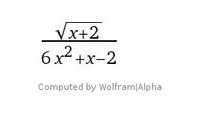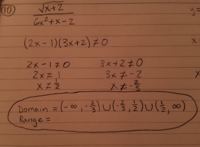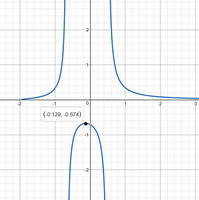You are using an out of date browser. It may not display this or other websites correctly.
You should upgrade or use an alternative browser.
You should upgrade or use an alternative browser.
Need help finding the range of a function.
- Thread starter saladtim
- Start date
Steven G
Elite Member
- Joined
- Dec 30, 2014
- Messages
- 14,603
Set the equation equal to K and then solve for x.
Now this is the x that when you plug into this equation will give you k, so k is in the range. Now for example if you solve for x and get x= 1/(k-3). Now there is no x when k=3. So k is NOT in the domain.
Now this is the x that when you plug into this equation will give you k, so k is in the range. Now for example if you solve for x and get x= 1/(k-3). Now there is no x when k=3. So k is NOT in the domain.
Dr.Peterson
Elite Member
- Joined
- Nov 12, 2017
- Messages
- 16,876
I think solving for x will require solving a quartic equation, so that probably won't work well.
I would try sketching the graph, using the derivative and other tools to find local maxima or minima, which can be put together to find the range.
I would try sketching the graph, using the derivative and other tools to find local maxima or minima, which can be put together to find the range.
- Joined
- Nov 24, 2012
- Messages
- 3,021
I think solving for x will require solving a quartic equation, so that probably won't work well.
I would try sketching the graph, using the derivative and other tools to find local maxima or minima, which can be put together to find the range.
Yes, that's there I was eventually going to head, after using the domain the identify vertical asymptotes, etc.
Otis
Elite Member
- Joined
- Apr 22, 2015
- Messages
- 4,589
Hello. Good job, but you've got a bit more work to do, on that domain. So far, your result shows all values that won't lead to zero in the function's denominator. Next, you need to eliminate values that make the numerator undefined. For example, what happens if you try to evaluate the function for x=-4?… This is what i came up with for the domain …
Are you allowed to use calculus, for finding the range? If not, I'm wondering whether you're allowed to use technology (like a graphing calculator) or a numerical method, to approximate a solution for the range.
?
Edit: Grammar typo
Last edited:
Next, you need to eliminate values that make the numerator undefined. For example, what happens if you try to evaluate the function for x=-4?
right thank you I totally skipped that step. going to reevaluate the domain.
Are you allowed to use calculus, for finding the range? If not, I'm wondering whether you're allowed to technology (like a graphing calculator) or a numerical method, to approximate a solution for the range.
?
We are not using calculus yet, but graphing calculators are allowed.
Maybe I am wrong about calculus not being allowed. I don't think the answer is wanted as a decimal as we are putting it into interval notation.Hmm...without the calculus it will be more difficult to analytically find the range...
I don't think we have learned how to solve with calculus, I think I am expected to get this information from the graph.
Last edited:
Otis
Elite Member
- Joined
- Apr 22, 2015
- Messages
- 4,589
Oh, good. You can zoom in on that local maximum point (between x-values -2/3 and 1/2).… graphing calculators are allowed.
?
Looks good to me, but I would replace the 'equal to' sign in the range statement to \(\displaystyle \approx\) because the decimal number is approximated.
?
Right that would be more accurate, thanks.
W|A gives an value of:
[MATH]y=\frac{9\sqrt{23+\sqrt{1969}}}{911-23\sqrt{1969}}\approx-0.674095748943020[/MATH]
for that local maximum in the middle.
Okay yeah that is definitely not something we have learned, but I honestly appreciate the time you've put into helping me out here. Both you and Otis have helped me get a much better understanding of this problem. You guys are seriously rock stars.
mmm4444bot
Super Moderator
- Joined
- Oct 6, 2005
- Messages
- 10,958
Don't forget to change the status of your thread from 'Unsolved' to 'Solved'.
?
?




